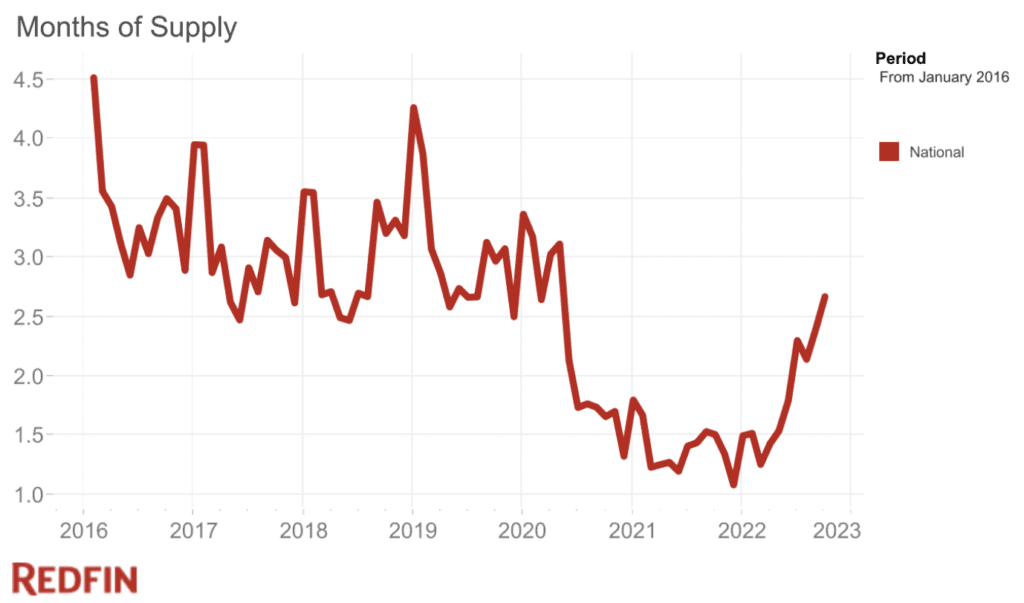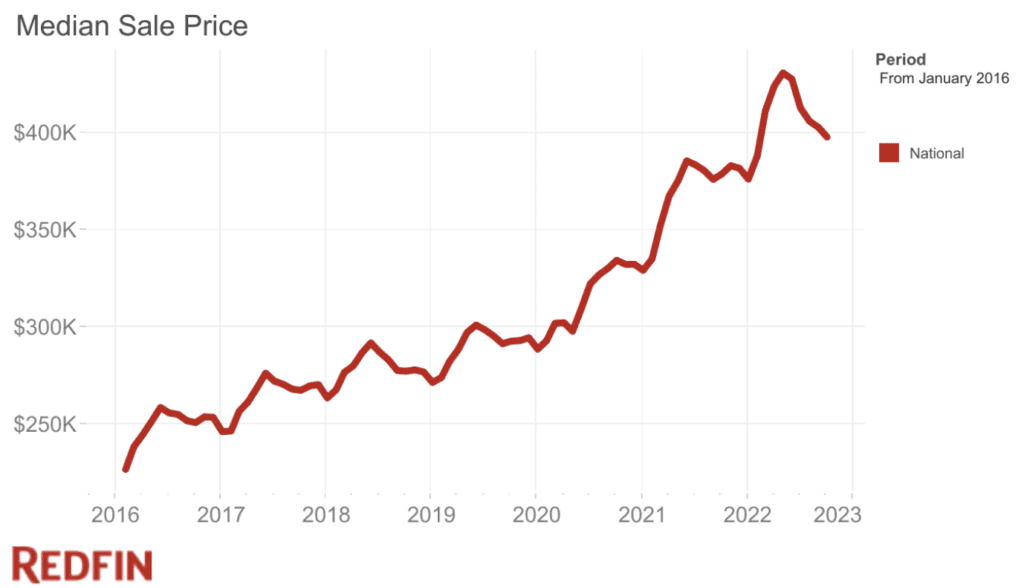It’s finally over! The crazy, unpredictable, and just plain weird housing market of 2022 has ended. Though analysts like me will likely be studying the 2022 housing market for years to come, we can finally take a quick look back at what happened this year and infer what might be in store for the year to come.
2022 was a tale of two halves. January through May/June was one type of market, and July through December was a very different market. It’s not possible to determine the shift’s exact date, but it was within this timeframe.
The First Half
Through the first half of 2022, we saw a continuation of the wild appreciation that defined 2021. Every major variable that influences housing prices was putting upward pressure on the market. There was strong demographic demand fueled by millennials reaching their peak home-buying years. A decade of underbuilding contributed to a nationwide housing shortage. Inventory was almost non-existent. And, of course, mortgage rates were historically low.
But then, things changed. In March of 2022, the Federal Reserve started raising the federal funds rate, pushing up bond yields and mortgage rates. The change of policy actually spiked demand as homebuyers and sellers rushed to transact before the full impact of higher mortgage rates were felt. This, combined with normal seasonality, allowed the party to continue and for prices to continue going up for a few extra months.
The Second Half
Eventually, the impact of skyrocketing mortgage rates took hold. Already facing ultra-high home prices, higher mortgage rates priced many homebuyers out of the market, and demand fell. When demand falls, inventory tends to rise, which is exactly what happened.

As inventory rose, sellers who were drunk on power over the last several years started to lose their leverage. Slowly, buyers started to have more options, and a bit of balance returned to the market, pushing down prices.

Some of the decline since June is seasonal, but as of December 2022, prices are down almost 10% off their May peak, and a typical seasonal decline is 5%-7%. The descent from the summer peak was deeper in 2022.
It’s worth noting that although prices are declining, they are not in free fall. Prices remain up year-over-year, and inventory has started to moderate. Mortgage rates have come down from October to December, and there are signs that the drop-off is becoming less steep. At this point, we remain in a correction, but not a crash.
What Will Happen In 2023?
Will we see a continuation of the downward trend we’re in now? Will things get worse? Or could the market reverse?
To me, it will again be a tale of two halves. I believe in the first half of 2023, we’ll see a continuation of the market we’re in now: sellers don’t want to sell, and buyers don’t want to buy. Of course, deals are still underway, but I expect sales volume to remain well below what we’ve seen for the last 7-10 years. Even though inflation is moderating, there remains too much uncertainty in the economy for the market to stabilize fully.
Hopefully, during the first half of 2023, we will see inflation come down and get more clarity about what is happening with the global economy. But what really matters for housing volume and home prices is about one thing: affordability. If housing stays as unaffordable as it is now, sales volume and appreciation will stay low. If affordability recovers, I expect the housing market to stabilize and perhaps even see a modest recovery in the second half of 2023.
It sounds overly simplistic, but housing is just too unaffordable in current market conditions. Some estimates say that housing is the least affordable it’s been in over 40 years. Until this changes, the housing correction is here to stay. The housing shortage and demographic demand haven’t gone anywhere. As soon as affordability improves, I think housing market activity will resume.
Will Affordability Improve?
Affordability is made up of three factors:
- Real wages
- Home prices
- Mortgage rates
Affordability can improve if wages go up or home prices and/or mortgage rates decline. Let’s take a quick look at if any of these things can happen.
Real wages
According to the Bureau of Labor Statistics, real (inflation-adjusted) wages are down about 2% year-over-year but have ticked up about 0.5% since September. Nominal (not inflation-adjusted wages) is actually up a lot, but inflation is too high and wipes out all of those gains.
| Real Earnings | November 2021 | September 2022 | October 2022 | November 2022 |
|---|---|---|---|---|
| Real average hourly earnings | $11.21 | $10.95 | $10.95 | $11.00 |
| Real average weekly earnings | $390.20 | $377.71 | $377.80 | $378.42 |
Although it’s a positive sign that real wages have ticked up a bit, it’s very modest. It is possible that, as inflation moderates, real wages will go up—but I find it unlikely that that will happen in a meaningful way. To me, concerns about a slowing economy will slow the pace of wage growth alongside inflation. Therefore, no real progress on real wages will be made.
Housing prices
One area where affordability is likely to improve is home prices. Residential real estate prices will likely see year-over-year declines nationally, making homes more affordable. For affordability to really improve, we’d probably have to see prices drop more than 10%, and it’s very unclear if that will happen. If prices drop at all, and by how much, it will depend very much on mortgage rates.
Mortgage rates
Mortgage rates can be confusing, especially recently. The Fed continues to raise the federal funds rate and has signaled they intend to keep doing so into 2023. Yet, mortgage rates are falling. What’s going on here?
Mortgage rates are not directly tied to the federal funds rate. Instead, it is very closely tied to the yield on 10-year treasuries. So, in a way, mortgage rates are more influenced by bond investors than by the Fed (although bond investors are highly influenced by the Fed. It’s confusing, I know).
Over the last several weeks, bond yields have fallen for two reasons. First, inflation is moderating faster than expected, which tends to cause a rally in bonds, sending bond yields down.
Secondly, there are fears of a global recession. These fears tend to prompt global investors to seek the safety of U.S. Treasury bonds, which pushes bond prices up and bond yields down. When bond yields fall, mortgage rates also tend to fall, which is exactly what we’re seeing. So, mortgage rates may fall next year and end the year somewhere between 5.5% and 6.5%, down from the most recent peak of 7.23% in October 2022.
Conclusion
If my premise that the 2023 housing market hinges on affordability is correct, then there are two plausible outcomes for the second half of 2023.
First, mortgage rates fall, along with modest price declines (less than 10%), combining to increase affordability during the second half of 2023. This would likely cause a bottoming of the housing market in Q1 2024, and we’d start to see growth in the market again come early 2024.
The other option is affordability doesn’t improve in 2023, probably due to persistently high inflation and mortgage rates. If that happens, the second half of 2023 will look like the first half of 2023, and we’re likely in for a longer correction. In this scenario, we will probably see housing prices drop 10-20% over the next two years, and we won’t see a bottoming of the market until late 2024/early 2025.
It’s tough to know what will happen, given the amount of economic uncertainty. As of this writing, I think the first scenario is more likely given the recent trends in inflation and bond yields. But both options are reasonably likely at this point. Unfortunately, the next twelve months are cloudy at best.
What do you think will happen in 2023? Let me know in the comments below.
On The Market is presented by Fundrise

Fundrise is revolutionizing how you invest in real estate.
With direct-access to high-quality real estate investments, Fundrise allows you to build, manage, and grow a portfolio at the touch of a button. Combining innovation with expertise, Fundrise maximizes your long-term return potential and has quickly become America’s largest direct-to-investor real estate investing platform.
Note By BiggerPockets: These are opinions written by the author and do not necessarily represent the opinions of BiggerPockets.
